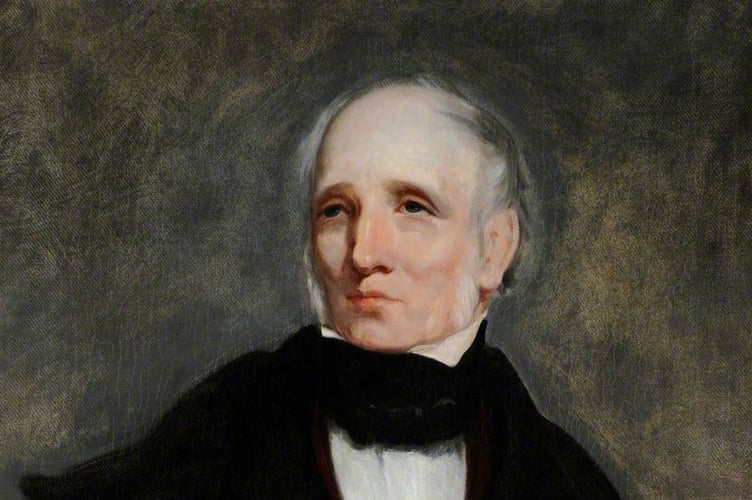WORDSWORTH IN THE WYE VALLEY
One of the most famous writers who visited the lower Wye Valley in the eighteenth century, was the famous poet William Wordsworth who was born on April 7, 1770 at Cockermouth, Cumberland. He was the second of five children and his father was a fairly prosperous estate manager. Sadly, his mother died when he was just seven and his father passed away six years later.
William was sent by a guardian to a grammar school at Hawkshead in the Lake District, where he received an excellent education in classics, literature and mathematics. He completed his education at Cambridge University in 1791 and four years later he received a legacy of £900 which enabled him to pursue a career as a poet.
He first came to the Wye Valley at the age of twenty-three on a solitary walking tour in August 1793 whilst living in the Lake District. It would have been no easy journey in those times to reach this area.

Writing in his journal, he commented: ‘The Wye is a stately and majestic river from its width and depth, but never slow and sluggish; you can always hear its murmur. It travels through a woody country, now varied with cottages and green meadows, and now with huge and fantastic rocks.’
He had no doubt been encouraged to see this river scenery and the ruins of Tintern Abbey by the descriptions of Thomas Gray and William Gilpin. Also, at this time because the wars of the French Revolution had closed Europe to gentlemen wishing to do the Grand Tour, the attractions of the Wye Valley were becoming well known.
Wordsworth, five years later, in July 1798, decided to make a second visit and his sister Dorothy went with him. They crossed the Severn by ferry from Aust to Beachley and walked to Tintern, where they stayed the night. It is possible that Wordsworth had been reading Gilpin’s Observations on the River Wye and this inspired him to write his famous poem Lines Composed a Few Miles above Tintern Abbey.

’The poem begins: ‘Five years have passed, five summers with the length / Of five long winters! and again I hear / These waters, rolling from their mountain springs/ With a soft inland murmur.
He writes of his yearning for this river: ‘O sylvan Wye! thou wanders thro’ the woods, / How often has my spirit turned to thee !’ At one point he ‘reposes’ or relaxes under the shade of ‘a dark sycamore’ and lists all the specific parts of the views that he remembers on his last visit.
Surprisingly, he does not mention the ruined Abbey or the valley as it would have appeared in 1798 with its industrial activities that would have been prominent at that time. He just concentrates on what he wants to see, which is just the idyllic landscape.
He comments on the small gardens around the cottages and the groups of fruit trees which, in the distance, look like ‘tufts’ instead of individual trees. Because it is still early in the summer, the fruit is not ripe yet, so they are all the same shade of green as the surrounding groves and copses.
Sitting on a boat making its way down the Wye towards Chepstow, Wordsworth would have looked across at the high limestone cliffs Known as Wyntour’s Leap and says:
‘Once again / Do I behold these steep and lofty cliffs, / That on a wild secluded scene impress / Thoughts of more deep seclusion.’
He tells us that the poem was begun ‘soon leaving Tintern, after crossing the Wye and concluded ‘just as I was entering Bristol in the evening… Not a line of it was altered and not any part of it written down till I reached Bristol.’
The poem is written in blank verse and its style is very fluid and natural, making it as easy to read as a piece of prose. Wordsworth has the ability to make us feel that we are there with him, appreciating the colour and beauty of the natural world.
His most famous poem is undoubtedly, ‘I wandered lonely as a cloud’ which is also sometimes called ‘Daffodils’ and was written in 1804, It was inspired by a walk with his sister Dorothy, near Ullswater in the Lake District and he is describing how a group of golden flowers represent qualities of nature such as hope, peace and joy.
In 1843 William Wordsworth succeeded his friend Robert Southey as Poet Laureate of England, though by this time he had for the most part stopped composing verse. He held this post until his death in 1850 and is undoubtedly the most famous nature poet in English Literature. This is because he had a deep love for the ‘beauties of the natural world’ and the ability to compare nature to everyday life in his poems that are renowned for their lyrical rhythm.
Dove Cottage, built in the 17th century, on the edge of Grasmere in the Lake District was the famous home of William Wordsworth and his sister Dorothy from December 1799 to May 1808. The Wordsworth Trust was founded in 1891 to secure the cottage and a museum built there opened in 1981, tells the story of the poet’s remarkable life and how he changed literature forever.
This whitewashed cottage was the very place where his most famous poem was written and it is visited by people from all over the world.
William Wordsworth died at Rydal Mount, Westmorland, on 23 April 1850 at the age of 80, after catching a cold on a country walk, and then pleurisy. He was buried in the graveyard of St Oswald’s Church, Grasmere, near some yew trees that he had planted.
On 7, April 2020, the 250th anniversary of the birth of William Wordsworth was marked by the Royal Mail with the issue of a commemorative postage stamp. It was also marked on BBC Radio 4’s Today programme and as part of the celebration, the Prince of Wales recorded an excerpt from ‘Lines composed above Tintern Abbey’.
Prince Charles (now King Charles) explained, ‘I chose this poem by Wordsworth, because funnily enough, I know that rather wonderful area around Tintern Abbey, up the Wye Valley. I can understand so well the way in which, Wordsworth and for a lot of people, the power of the landscape to move us, is something rather profound.’
In March 2018, Prince Charles who had been a Patron of the Wordsworth Trust since April 1996, designated the Lake District National Park, as a UNESCO World Heritage Site. This was very appropriate for the landscape is intrinsically linked with so much of Wordsworth’s writing.
William Wordsworth was undoubtedly the central figure in the English Romantic revolution in poetry, for he formulated in his poems and essays a new attitude towards nature. He gave a fresh view of the organic relation between man and the natural world, and created some of the greatest English poetry of his century.




